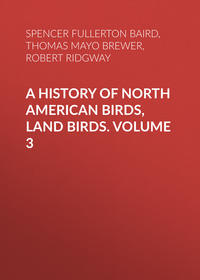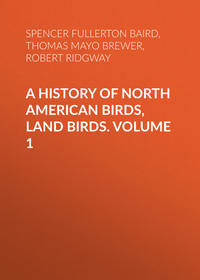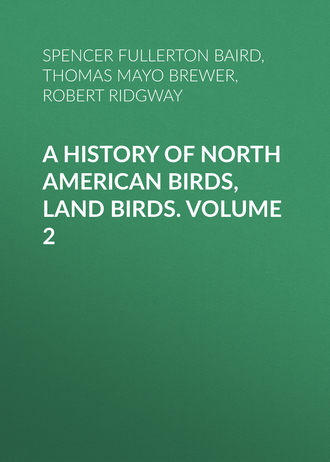 полная версия
полная версияA History of North American Birds, Land Birds. Volume 2
The species are all of rather small size and rather plain appearance, from the uniformity of their green, or green and white, coloring. They belong to northern South America, and to Central America north to Guatemala.
The genus is included in the North American fauna solely upon the accidental occurrence of one species (T. linnæi) in Eastern Massachusetts.
Thaumatias linnæi, BonapLINNÆUS’S EMERALDThaumatias linnæi, Bonap. Rev. et Mag. de Zoöl. 1854, 255. Thaumatias l. Gould, Monog. Trochilid. pl. ? Trochilus tobaci, Gmel. Syst. Nat. I, 498. ? Trochilus tobagensis, Lath. Ind. Orn. I, 316. ? Trochilus tobago, Shaw, Gen. Zoöl. viii, 350. Ornismya viridissima, Less. Hist. Nat. 257, pl. lxxv. ? L’Oiseau-mouche à poitrine verte (Trochilus maculatus), Aud. et Vieill. Ois. Dor. tom. I, 87, pl. xliv. Argyrtria maculata, Maynard, Birds E. Mass. 1870, 128 (Cambridge, Mass.!).
Sp. Char. Continuous green, darker above, more brilliant, and of an emerald tint on the throat and jugulum; crissum, anal region, and middle of the abdomen, white. Primaries plain dusky. Tail blackish, with a faint reflection of dark blue subterminally, and of dull green basally, the lateral feathers obscurely tipped with dull dark ashy. Sexes alike. Wing, about 2.00; bill, .70.
Hab. Northern Brazil, Guiana, Tobago, and Bogota (Gould)?? Accidental in the eastern United States (Cambridge, Mass., Maynard).
This race much resembles the T. albiventris, (Reichenb.) Bonap. (Gould, Monog. Troch., Vol. V, p. ccci), of Brazil, but is said to be smaller and with less white on the abdomen and the under tail-coverts tinged with gray.
Habits. The single specimen of this Humming-Bird, referred to by both Mr. Maynard and Mr. Allen119 as having been taken in Massachusetts, is said to have been shot by Mr. William Brewster in the summer of 1868, in Cambridge, near Mount Auburn. It was secured by accident, and was presumed to be, when taken, a female specimen of Trochilus colubris. It was sent to Mr. Vickary, of Lynn, to be mounted, and the question has been raised if by chance a South American bird may not have been substituted for the original. This, however, Mr. Vickary is positive could not have happened. Nothing distinctive was observed as to its habits. In view, however, of the possibility of an error, the propriety of including it in our fauna is very questionable.
The three families next in order are those generally known as the Zygodactyli, in their more restricted sense, that is, having the toes arranged in pairs, two before and two behind. In the present case the anterior toes are the inner and the middle (the second and third), the posterior being the hinder and outer (the first and fourth); where, as is sometimes the case, a hind toe is wanting, it is the first, or the hind toe proper.
By this definition we exclude the Trogonidæ, the Bucconidæ, and the Galbuilidæ, which likewise have the toes in pairs, but in which they are differently combined.
The North American families, the Cuculidæ, the Picidæ, and the Psittacidæ, are defined as follows:—
A. Upper mandible not movable nor hinged. Tarsus with transverse scutellæ. Bill without a naked skin, or cere, at the base; lower mandible much longer than deep, the end not truncated.
a. Tongue short, and not extensible; not barbed at the point.
Bill hooked or curved at tip; not constructed for hammering. No nasal tufts … Cuculidæ.
b. Tongue long and cylindrical, and generally capable of great extension; barbed at the point.
Bill not hooked, but nearly straight; strong, and constructed for hammering. Thick nasal tufts at base of the bill (except in the Nudinares) … Picidæ.
B. Upper mandible movable or hinged. Tarsus without transverse scutellæ. Bill with a naked skin, or cere, at the base; lower mandible not longer than deep, its end truncated.
c. Tongue short and thick, fleshy.
Bill enormously large, much curved, the upper mandible hooked, both much arched … Psittacidæ.
Family CUCULIDÆ.—The Cuckoos
Char. Bill compressed, usually more or less lengthened and with decurved culmen. Rictal bristles few or none. Nostrils exposed, no nasal tufts. Tail long and soft, of eight to twelve feathers. Toes in pairs, deeply cleft or not united, the outer anterior toe usually versatile, but directed rather laterally than backward.
The Cuculidæ form a strongly marked group of birds, easily distinguished among the Zygodactyli by the characters given above. The outer toe is versatile, but in the American form is more lateral than posterior in the skin, standing sideways, or even anterior, more frequently than behind.
Modern systematists divide the family into six or more subfamilies, of which two only are American, none of these having more than ten tail-feathers. These may be characterized as follows:—
Coccyginæ. Face covered with feathers; bill elongated, more or less cylindrical, straight or curved. Tail of ten feathers.
Bill about the length of the head, or not longer; curved. Loral feathers soft. Legs weak, tarsus shorter than the toes. Arboreal … Coccygus.
Bill longer than the head; straight. Loral feathers stiff, bristly. Tarsi much longer than the toes. Terrestrial … Geococcyx.
Crotophaginæ. Face naked. Bill much compressed, with a sharp crest. Tail of eight feathers. Bill shorter than and nearly as high as the head … Crotophaga.
Subfamily COCCYGINÆ
Genus GEOCOCCYX, WaglerGeococcyx, Wagler, Isis, 1831, 524.
Leptostoma, Swainson, Classification Birds, II, 1837, 325.
Gen. Char. Bill long and strong, slightly compressed, and at least as long as the head; head crested; loral feathers, and those at base of bill, stiffened and bristly. Nostrils elongated, linear. A naked colored skin around and behind the eye; the eyelids ciliated. Tarsi longer than the toes; very stout. Wings very short and concave; the tertials as long as the primaries. Tail longer than the head and body; composed of ten narrow, much graduated feathers.
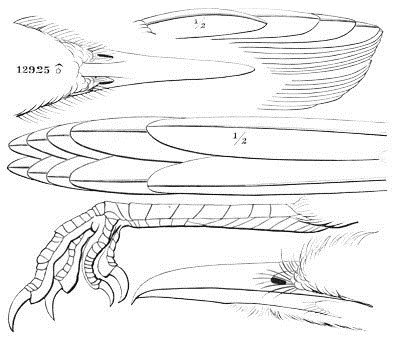
Geococcyx californianus.
12925 ♂
This remarkable genus is represented in the United States by a single species, known as the Paisano, Chaparral Cock, or sometimes Road-Runner, on account of its frequenting public highways. Its very long legs enable it to run with great rapidity, faster even than a fleet horse. A second species occurs in Mexico, the Geococcyx affinis of Hartlaub. This is smaller, and differently proportioned. In both the feathers above are bronzed brown and green; nearly all with opaque white edges; beneath white, with black streaks on the sides of neck and breast; the feathers with broad white tips; the principal differences are as follows:—
G. californianus. Bill above, about 2.00; gape nearly straight to near tip; nostril behind middle of gape. Feathers of throat and upper part of breast light brownish, with shaft-streaks of black. Hab. Southwestern United States, from Cape St. Lucas and Southern California to Texas.
G. affinis. 120 Bill above about 1.60; gape gently curved throughout. Nostril opposite middle of gape. Feathers of throat and breast fulvous-white, without shaft-streaks, except on the sides, where they are broad and abruptly defined. Hab. Mexico, from Mazatlan to Xalapa.
This last species is common at Mazatlan, as well as elsewhere in Mexico, and may yet be found in Arizona.
Geococcyx californianus, BairdPAISANO; ROAD-RUNNER; CHAPARRAL COCKSaurothera californiana, Lesson, Buff. VI, 1829, 420.—Botta, Ann. du Mus. 1835, 121, pl. (Cape St. Lucas to San Francisco). Geococcyx variegata, Wagler, Isis, V, 1831, 524. Saurothera bottæ (Blainville), Lesson, Traité d’Orn. I, 1831, 145. Diplopterus viaticus (Licht.) Boie, Isis, 1831, 541 (no description). Geococcyx viaticus, Hartlaub, Rev. Zoöl. 1844, 215.—M’Call, Pr. A. N. Sc. III, July, 1847, 234.—Bon. Consp. 1850, 97.—Ib. Consp. Zygod. in Aten. Ital. 1854, 5.—Heermann, J. A. N. Sc. Ph. 2d series, II, 1853, 270.—Newberry, Zoöl. Cal. and Oregon Route, 91, P. R. R. Rep. VI, 1857. Saurothera marginata, Kaup, Isis, 1832, 991; tab. xxvi (fig. of head and foot). Leptostoma longicauda, Swainson, Birds, II, 1837, 325.—Gambel, Pr. A. N. S. I, 1843, 263. Geococcyx mexicanus, Gambel, J. A. N. Sc. 2d series, I, 1849, 215 (not of Gmelin).—Cassin, Ill. I, 1855, 213, pl. xxxvi.—Sclater, Catal. 324, 1862.—Heerm. X, S, 59 (nest). Geococcyx californianus, Baird, Birds N. Am. 1858, 73.—Cooper, Orn. Cal. 1, 1870, 368.
Sp. Char. Tail very long; the lateral feathers much shortest. An erectile crest on the head. A bare skin around and behind the eye. Legs very long and stout.
All the feathers of the upper parts and wings of a dull metallic olivaceous-green, broadly edged with white near the end. There is, however, a tinge of black in the green along the line of white, which itself is suffused with brown. On the neck the black preponderates. The sides and under surface of the neck have the white feathers streaked centrally with black, next to which is a brownish suffusion. The remaining under parts are whitish, immaculate. Primary quills tipped with white, and with a median band across the outer webs. Central tail-feathers olive-brown; the others clear dark green, all edged, and (except the central two) broadly tipped with white. Top of the head dark blackish-blue. Length, 20 to 23 inches; wing, about 6.50; tail, 12 to 13. Size generally very variable.
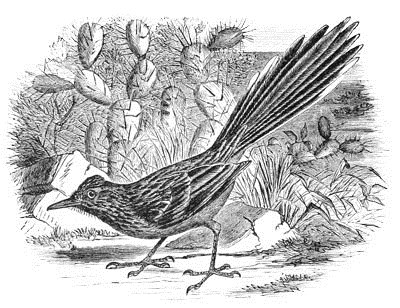
Geococcyx californianus.
Hab. Middle Texas, New Mexico, and California to Central Mexico. Seen as far north as Fort Reading, California, and Fort Chadbourne, Texas. Localities: Southeast Texas (Dresser, Ibis, 1865, 466, resident); W. Arizona (Coues, P. A. N. S. 1866, 57); Cape St. Lucas (Xantus); Kioway Agency (Dr. Palmer).
There are seemingly no differences of plumage depending on sex, age, or season.
In calling this species Geococcyx californianus we do not feel entirely sure that we have selected the earliest name. Hartlaub and other authors give 1829 as the date of Lesson’s Vol. VI, of complement to Buffon (VI, 420). A copy of this volume in the Library of Congress bears date of 1834 upon the titlepage. It is, however, quoted at the date of 1829 by Engelmann, so that the copy referred to above may possibly be a second edition, or with a new post-dated titlepage. In this uncertainty, however, we prefer to retain the name of californianus.
Botta, in his description of the bird (the original of Lesson’s species), speaks of it as occurring from Cape St. Lucas to San Francisco. Specimens from Cape St. Lucas, brought by Mr. Xantus, are smaller than those of Upper California, but otherwise apparently identical.
Habits. This very remarkable bird, variously named, in Mexico, Texas, and California, the Paisano, the Road-Runner, the Chaparral Cock, the Ground Cuckoo, the Prairie Cock, and the Corre-camino, is one of the most curious and interesting of the recent additions to our ornithological lists. It is found throughout Northern Mexico, Texas as far north as Port Chadbourne, and in California as far as Fort Reading. It is also abundant in portions of Arizona and New Mexico, and is supposed to be resident in all these districts. It is described as very remarkable for great swiftness of foot, in which it appears to be equalled by no other North American bird. In Mexico, and in some parts of the United States, it is not unusual to hunt these birds, as a matter of amusement, on horseback, and to pursue them with hounds,—a test of their fleetness in which they are said to often make a longer race than their pursuers anticipated.
This bird habitually frequents the ground. When walking or running, its long tail is borne in an erect position, and often assumes a variety of grotesque positions. While thus more or less terrestrial in its habits, and sharing with gallinaceous birds many of their peculiarities, it has no other affinities with them, but ranks in a very different ornithological division, being classed with the Cuckoos.
This bird was first brought to the attention of American naturalists by Dr. William Gambel, who published a description of it in 1845. Two years afterwards Colonel McCall published the first satisfactory account that has been given of its habits and manners of life. He states that though this bird is zygodactyle, with toes disposed in opposite pairs, yet that the reversibility of the outer toe favors its use for climbing or perching, as well as for movements on the ground.
The food of the Ground Cuckoo consists of coleopterous and almost every other description of insects, and where snails abound they also are greedily eaten. These are usually taken either from the ground or a branch, and carried to a particular spot, where the shell is broken and its contents eaten. Piles of these shells are often found thus collected in places frequented by them. They are also said to be ready and expert in catching their prey in the air, sometimes springing up to the height of eight or ten feet. In these performances the wings and tail are expanded for but a moment, the bill is heard to snap as the insect is seized, and the bird drops again suddenly to the ground.
Colonel McCall adds that the general impression that its powers of flight are very limited is not correct. When suddenly alarmed in open ground, it rises with a light quick motion, and flies some hundreds of yards continuously with an ease that attests its ability to maintain even a longer flight. He has often seen it climb to the top of a straight leafless branch, and there sit, apparently to enjoy the first rays of the morning sun.
They are shy and retiring in disposition, wary, vigilant, and cautious, so that it is generally difficult to approach them on the open ground. When suddenly surprised and driven to fly a considerable distance for cover, though they fly with evident ease, they rarely rise higher than six or eight feet from the ground. In evidence of its wonderful swiftness of foot, Colonel McCall states that when on one occasion, approaching Limpia Creek, in Texas, with a small party, he discovered a Chaparral Cock in the open road, about a hundred yards in advance, for his amusement he put spurs to his horse, and dashed after the bird with one of the men. It was thus pursued for full four hundred yards along a smooth and level road, over which with straightened neck and slightly expanded wings it swiftly glided without seeming to touch the ground. When at last it sought shelter in the thicket, they had not gained upon it more than fifty yards.
Captain McCown kept a young half-grown bird in confinement, but it refused to eat, and soon died; others, however, have been more fortunate, and have succeeded in taming them.
Dr. Heermann states that the stomachs of all these birds examined by him were filled with the grasshoppers and the large black beetles found on the plains. A nest of this bird was found by him, built on the branches of the cactus, and constructed of loose sticks put negligently together in a manner similar to the nests of the Yellow-billed Cuckoos. It contained two large white and nearly spherical eggs.
Dr. Gambel states that these birds devour reptiles as well as other insects, which is also confirmed by the observations of Mr. Arthur Schott.
Lieutenant Couch mentions that this bird, called Paisano by the Mexicans, is also held in high estimation by them on account of its enmity to the rattle-snake, which it usually succeeds in killing in fair combat. Though by no means deficient in courage, it is represented as remarkably quiet and harmless in its habits. The only note he heard from it was a weak scream, which is seldom uttered. It is unsocial, is never seen in flocks, and rarely wanders from its restricted locality.
In regard to their note, Dr. Cooper mentions hearing one at Fort Mohave making a low cooing noise like that of a dove, for which it was at first mistaken. He afterwards heard it cooing harshly and chattering its mandibles together, at the same time jerking up its tail and erecting its crest.
Where not molested, Dr. Cooper states that they become quite tame, and seem to have a preference for towns and houses. At Santa Barbara he observed one young bird nearly fledged as early as May.
Mr. A. J. Grayson had one of these birds in confinement, which became quite tame, and readily fed upon any kind of raw meat, but preferred lizards and small birds, the latter of which it swallowed, feathers and all. If given to him alive, he would play with them awhile before swallowing them, as a cat does with a mouse. They are sometimes tamed, and kept about gardens to kill mice and insects. Dr. Kennerly also states that when taken alive they soon become quite tame, and willingly remain about a house, soon destroying all the mice in the vicinity, which they catch with as much dexterity as a cat.
Mr. Dresser found this bird abundant throughout the mesquite regions, and more particularly so near the Rio Grande. He found its eggs near San Antonio in April and May, and received them even as late as the 23d of September. They build a clumsy nest of mesquite twigs, placed at some height on a bough or in a hollow tree, and lay from two to four pure white eggs. The stomachs examined by Mr. Dresser were found to contain small snakes, lizards, and ticks. He had one in a semi-domesticated state at Matamoras, which became very tame, and was so mischievous that he could not let it remain in the house. It would steal and hide everything that it could carry off, and was particularly fond of tearing up letters and upsetting the inkstand. It was never caged or tied up, and would frequently pay the neighbors a visit, always returning before evening. He fed it on raw meat and lizards. It flew with great ease, and was very fond of perching on the house-top. This bird had a singular antipathy to a tame parrot, and whenever the latter was let out of the cage, it would get into a rage, and either go to the house-top or decamp to some of the neighbors.
The eggs are white, of a rounded oval, equal at either end, and measure 1.60 by 1.22 inches.
Genus COCCYGUS, VieillotCoccyzus, Vieillot, Analyse, 1816. (Type, Cuculus americanus, Linn.)
Erythrophrys, Swainson, Class. Birds, II, 1837, 322.
Gen. Char. Head without crest; feathers about base of bill soft; bill nearly as long as the head, decurved, slender, and attenuated towards the end. Nostrils linear. Wings lengthened, reaching the middle of the tail; the tertials short. Tail of ten graduated feathers. Feet weak; tarsi shorter than the middle toe.
The species of Coccygus are readily distinguished from those of Geococcyx by their arboreal habits, confining themselves mainly to trees, instead of living habitually on the ground. The plumage is soft, fine, and compact.
The American Cuckoos differ from the European (Cuculus) by having lengthened naked tarsi, instead of very short feathered ones. The nostrils, too, are elongated instead of rounded. The habits of the two are entirely different, the American species rearing their own young, instead of laying the eggs in the nests of other birds, like the European Cuckoo and the American Cowbird (Molothrus pecoris).

Coccygus americanus.
1541 ♂
The following synopsis will serve to distinguish the North American species of Coccygus, with their more nearly related southern allies, all of them being of a light greenish color above, tinged with ashy towards the head:—
Species and VarietiesA. Tail-feathers except two middle ones black, with broad, sharply defined terminal spaces of white.
a. Lower mandible yellow.
1. C. americanus. Beneath pure white, with an ashy shade across the jugulum. Inner webs of primaries mostly rufous. Auriculars nearly concolor with the nape. Length, 12.00; wing, 5.45; tail, 5.64; culmen, 1.00; tarsus, .90. Hab. United States (very rare in the Western Province), Jamaica, Porto Rico.
2. C. minor. Beneath ochraceous, generally paler anteriorly. Inner webs of primaries without any rufous. Auriculars blackish, conspicuously different from the nape. Length, 12.00; wing, 5.30; tail, 7.50; graduation of tail, 2.75. Tail-spots about 1.00 long. Hab. West Indies, and Northern and Eastern South America, Southern Florida.
b. Lower mandible blackish like the upper (pale blue in life).
3. C. melanocoryphus.121 Colors similar to those of C. minor, but upper parts more brown. Wing, 4.50; tail, 5.85; graduation of the tail, 2.00. Tail-spots about .50 long. Hab. South America (Buenos Ayres, Peru, La Plata, Cayenne, etc.).
B. Tail-feathers all grayish-brown, with narrow terminal, obscure spots of white.
c. Lower mandible blackish like the upper (pale blue in life?).
C. erythrophthalmus. No rufous on primaries, except in young (which have black bill, brown tail-feathers, etc.). Beneath continuous white, with a faint ashy-buff shade across the jugulum; above grayish-brown. Bare eyelids bright red in the adult. Length, 11.30; wing, 5.12; tail, 6.24; tarsus, .90; culmen, 1.00. Hab. Eastern Province of the United States, south through eastern Middle America to Bogota.
Coccygus americanus, BonapYELLOW-BILLED CUCKOOCuculus americanus, Linn. Syst. Nat. I, 1766, 170, 10. Coccyzus americanus, Bon. Obs. Wilson, 1825, No. 47.—Ib. Conspectus, 1850, IV.—Aud. Orn. Biog. I, 1832, 18, V; 520, pl. ii.—Ib. Birds Am. IV, 1842, 293, pl. cclxxv.—Baird, Birds N. Am. 1858, 76.—Scl. Cat. 1862, 322.—Cooper, Pr. Cal. Ac. 1868 (Sacramento, Cal.)—Samuels, 83.—Cooper, Orn. Cal. 1, 1870, 371. Erythrophrys americanus, Sw. Birds II, 1837.—Bon. List, 1838. Cureus americanus, Bon. List, Eur. Birds, 1842. ? Cuculus dominicensis, Linn. Syst. Nat. I, 1766, 170, 13. ? Cuculus dominicus, Latham, Syst. I, 1790, 221 (considered distinct by Bonaparte). Coccygus dominicus, Baird, pl. Cuculus carolinensis (Brisson), Wilson, Am. Orn. IV, 1811, 13, pl. xxviii. Cuculus cinerosus, Temminck, Man. IV, 1835, 277. Coccyzus pyrrhopterus, Vieill. Dict. Coccygus bairdi, Sclater, P. Z. S. March, 1864, 120 (Jamaica; no rufous externally on wing). ? Coccygus julieni, Lawr. Ann. N. Y. Lyc. VIII, June, 1864, 42, 99 (Sombrero Island; no rufous on wing).
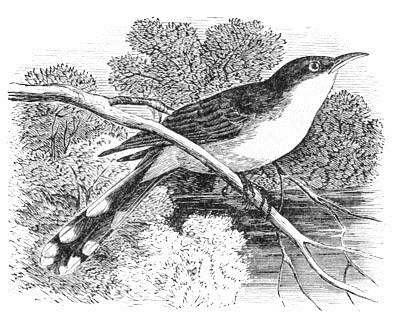
Coccygus americanus.
Sp. Char. Upper mandible and tip of lower, black; rest of lower mandible and cutting edges of the upper, yellow. Upper parts of a metallic greenish-olive, slightly tinged with ash towards the bill; beneath white. Tail-feathers (except the median, which are like the back) black, tipped with white for about an inch on the outer feathers, the external one with the outer edge almost entirely white. Quills orange-cinnamon; the terminal portion and a gloss on the outer webs olive; iris brown. Length, 12.00; wing, 5.95; tail, 6.35.
Hab. Eastern United States to the Missouri plains. California and Nevada (Ridgway); Mazatlan; Jamaica; Porto Rico. Localities: ? Sta. Cruz (Newton, Ibis, I, 149, eggs!); Cuba (Cab. J. IV, 154; Gundl. Rep. I, 1866, 295); Jamaica (Gosse, B. Jam. 279?) Costa Rica (Cab. J. 1862, 167); Lower Rio Grande (Dresser, Ibis, 1865, 466, breeds).
There is considerable variation in the amount of rufous in the quills; sometimes this shows very distinctly externally, sometimes it is entirely replaced by the bronzed olive of the back. A greater amount of the rufous seems to characterize the more southern and Jamaica specimens, which also are smaller; northern specimens, however, show similar variations. In the immature birds the under surface of the tail-feathers is gray, not black, so that the contrast with the white tips is very indistinct, as in erythrophthalmus, in which, however, these light tips are much narrower, while the bill is entirely black.


